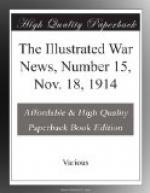Our first photograph shows where the “Emden” met her fate after landing a party to destroy the wireless station, the pole of which is seen to the left centre of the photograph. The Cocos group are a British possession, and lie in the Indian Ocean, south-west of Sumatra. Our second photograph shows the “Emden,” whose depredations have cost nearly two and a quarter millions sterling. She was a light cruiser of 3350 tons and 25 knots speed, carrying ten 41-inch guns. Captain Karl von Mueller, the “Emden’s” Captain, who carried out his enterprises with a fine spirit of chivalry and daring which we acknowledge, was a native of Blankenburg, in Brunswick, and was formerly a captain in the Hansa Line. He is a prisoner, unwounded, and keeps his sword.
_______________________________________________________
___________________ The illustrated war news, Nov. 18, 1914—37
[Illustration: The destruction of the “Emden” And the bottling-up of the “KOeNIGSBERG”: H.M.A.S. “Sydney” And H.M.S. “Chatham.”]
H.M.S. “Sydney” (No. 1) caught the commerce-raiding “Emden” at Keeling Cocos Island and forced a sharp action upon her, with the result that the German ship was driven ashore and burnt. The “Chatham” (No. 2) found the “Koenigsberg,” the ship, it will be recalled, which attacked the “Pegasus,” hiding in shoal water up the Rufigi River, German East Africa, with part of her crew entrenched on the banks. Unable to get at her, she bottled up the “Koenigsberg” by sinking colliers in the only navigable channel. The “Sydney” is a light cruiser of 5600 tons, launched, as was the “Chatham,” in 1911. The “Chatham” was practically a sister ship of the “Sydney,” but rather smaller, displacing 5400 tons, The “Emden” was of 3650 tons; the “Koenigsberg” displaced 3400 tons.—[Photos. by Symonds.]
_______________________________________________________
___________________ 38—The illustrated war news, Nov. 18, 1914.
[Illustration: The German trench-mortar just introduced to the British: A weapon which throws A 187-lb. Mine-shell.]
“In this quarter,” says Eye-Witness of the fighting near Ypres on October 29, “we experienced ... the action of the ‘minenwerfer,’ or trench-mortar. This piece, though light enough to be wheeled by two men, throws a shell weighing 187 lbs. The spherical shell has a loose stem which is loaded into the bore and drops out in flight. It ranges about 350 yards at 45 deg. elevation. The shell is a thin-walled mine-shell containing a large charge and is intended to act with explosive effect, not splinter-effect.” The diagram on the left shows one of the shells and its stem in their most up-to-date form; in the centre is the trench-mortar (its wheels off) with a shell in place; below this are three shells without their stems; on the right is a shell and its stem.




